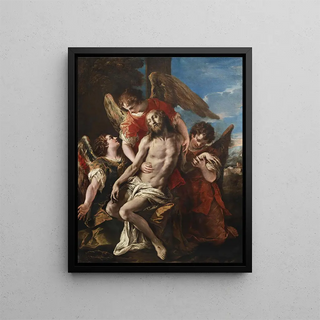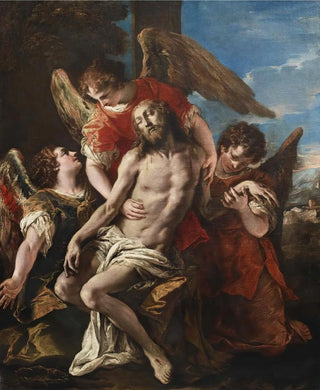Art print | The Christ Wept by Three Angels - Sebastiano Ricci


View from behind

Frame (optional)
In the enchanting world of Baroque art, "The Christ Wept by Three Angels" by Sebastiano Ricci stands as an iconic masterpiece, revealing the emotional depth and technical virtuosity of its creator. This painting, imbued with spirituality, transports the viewer to a moment of reflection and compassion, where the pain of loss is elevated by the beauty of the gesture. The presence of angels, celestial figures with faces filled with sadness, enhances the scene's intensity, offering a poignant depiction of Christ's suffering. Through this work, Ricci invites us to contemplate not only the human tragedy but also the light that emerges from darkness.
Style and uniqueness of the work
Sebastiano Ricci is distinguished by his unique approach to baroque, blending dynamism and delicacy. In "The Christ Wept by Three Angels," he manages to capture the tension between the divine and the human, between pain and consolation. The vivid colors and play of light, characteristic of his style, create an atmosphere that is both dramatic and serene. The drapery of the angels, rendered with remarkable precision, seems almost tangible, adding a tactile dimension to the piece. The composition, skillfully orchestrated, guides the viewer's gaze toward Christ's body while leaving space for contemplation of the angelic figures. Each face, each gesture, is charged with meaning, demonstrating an unparalleled mastery in expressing emotions.
The artist and his influence
Sebastiano Ricci, born in Venice in 1659, is a significant figure of Italian baroque art. His artistic journey, rich in diverse influences, led him to explore religious, mythological, and historical themes with unmatched passion. Ricci established himself on the artistic scene of his time, traveling across Europe and leaving an indelible mark in cities such as Venice, London, and Vienna. His style, both flamboyant and poetic, has inspired many contemporary and later artists, contributing to the evolution of baroque art toward more expressive forms. By integrating elements of the

Matte finish

View from behind

Frame (optional)
In the enchanting world of Baroque art, "The Christ Wept by Three Angels" by Sebastiano Ricci stands as an iconic masterpiece, revealing the emotional depth and technical virtuosity of its creator. This painting, imbued with spirituality, transports the viewer to a moment of reflection and compassion, where the pain of loss is elevated by the beauty of the gesture. The presence of angels, celestial figures with faces filled with sadness, enhances the scene's intensity, offering a poignant depiction of Christ's suffering. Through this work, Ricci invites us to contemplate not only the human tragedy but also the light that emerges from darkness.
Style and uniqueness of the work
Sebastiano Ricci is distinguished by his unique approach to baroque, blending dynamism and delicacy. In "The Christ Wept by Three Angels," he manages to capture the tension between the divine and the human, between pain and consolation. The vivid colors and play of light, characteristic of his style, create an atmosphere that is both dramatic and serene. The drapery of the angels, rendered with remarkable precision, seems almost tangible, adding a tactile dimension to the piece. The composition, skillfully orchestrated, guides the viewer's gaze toward Christ's body while leaving space for contemplation of the angelic figures. Each face, each gesture, is charged with meaning, demonstrating an unparalleled mastery in expressing emotions.
The artist and his influence
Sebastiano Ricci, born in Venice in 1659, is a significant figure of Italian baroque art. His artistic journey, rich in diverse influences, led him to explore religious, mythological, and historical themes with unmatched passion. Ricci established himself on the artistic scene of his time, traveling across Europe and leaving an indelible mark in cities such as Venice, London, and Vienna. His style, both flamboyant and poetic, has inspired many contemporary and later artists, contributing to the evolution of baroque art toward more expressive forms. By integrating elements of the






